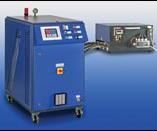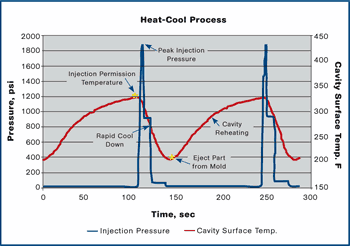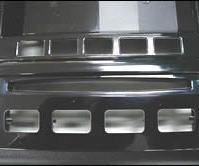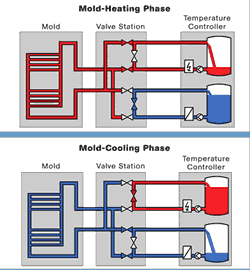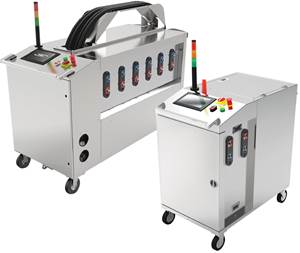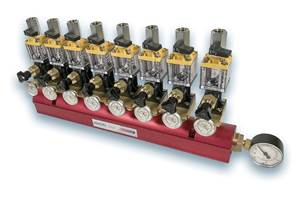Thermal Cycling of Injection Molds Boosts Surface Quality
In the injection molding process, tool temperature is an important factor in achieving high-quality parts.
In the injection molding process, tool temperature is an important factor in achieving high-quality parts. It is generally believed that higher tool temperature often results in better surface quality. Heat/cool molding technology is an approach to thermally cycling the mold surface temperature within the injection molding cycle. This requires heating the mold surface above the material’s glass-transition temperature (Tg) prior to injection, and then rapidly cooling the tool to solidify the molded part prior to ejection.
The heat/cool molding process significantly improves the surface appearance of injection molded parts. It is also possible to reduce system costs by eliminating secondary operations such as primers and sanding to hide surface defects. In some cases, painting or powder coating can be eliminated altogether. Heat/cool molding also enables the use of glass-reinforced structural materials in applications where a high-gloss finish is important. Other benefits of this approach include reduction of molded-in stress, reduction or elimination of jetting and visible weld lines, and increased resin flow lengths to produce thinwall parts.
SABIC Innovative Plastics began working on this technology in Japan several years ago. The first application was an automotive roof-rack rail support bracket that was converted from metal. When an 11% glass-filled Xenoy 1760 PC/PBT resin was trialed, surface aesthetics were not acceptable due to jetting and obvious weld lines. In addition, the part surface was very rough due to the glass fibers, and it required sanding prior to painting. Heat/cool technology eliminated these surface defects and the need for sanding.
With materials such as polycarbonate and blends like PC/ABS and PC/PBT, the heat/cool process is being used successfully to minimize surface-appearance issues in applications such as TV bezels, light-guide plates, car audio components, and notebook PC covers.
HOW IT WORKS
Conventional injection molding machinery can be used for heat/cool processing. However, a special auxiliary system is required for rapidly heating and cooling the mold surface. Both superheated water and steam are being used today. Some systems require an external boiler to generate steam, while others generate steam within the control unit itself. In the Pacific region, SABIC uses steam at its development centers. At the Polymer Processing Development Center (PPDC) in Pittsfield, Mass., the company is using a superheated water system from Germany’s Single Temperiertechnik (sold here by KraussMaffei) that can deliver water at 200 C (400 F).
For efficient process control, the mold must be equipped with thermocouples that are close to the molding surface to monitor temperature. The injection mold, the molding machine, and the heat/cool controller must be integrated to achieve a stable process. During the development of this process at SABIC, we built our own control unit to integrate each element.
At the outset of the molding cycle, steam or superheated water is circulated in the tool to heat the mold surfaces to a temperature 10° to 30° C above the Tg of the resin. Once this temperature is achieved, the injection machine is given a signal to inject plastic into the cavity. After the cavity is filled and the injection phase completed, cold water is circulated in the tool to quickly solidify the plastic and cool it sufficiently for ejection. A valve station is used to switch from steam or superheated water to cold water (and vice versa). After the part has cooled, the mold opens and the part is ejected, and the system switches back to the mold-heating phase.
FOCUS ON TOOL DESIGN
The effect of heat/cool technology on overall cycle time depends on the material being processed and, more importantly, on the design and construction of the tool. The time required to heat and cool the tool is a function of the steel’s mass, so it is best to minimize the amount of steel to be thermally cycled. Cavities and cores should be inserted rather than cut into the mold plates to help minimize mass. To reduce heat loss and improve efficiency, these inserts should be insulated from the cavity and core retainer plates using air gaps and insulation material whenever possible.
Besides reducing the amount of steel mass that must alternate from hot to cold, consideration should be given to the use of metals such as beryllium-copper or other highly conductive alloys to reduce the time required to heat and cool the mold surfaces. Also, placing water lines close to the molding surfaces will help speed up response time. Many times, however, the part geometry will not allow this. Conformal cooling, where the pattern of water lines mirrors the part surface geometry, is an approach that is well suited to this process.
Several different technologies are used to achieve conformal cooling, such as laser sintering and direct metal deposition. For a test mold, SABIC worked with Fast4M Tooling, which developed a laminate toolmaking process called Fast-Form. This technology builds the tool from a stack of thin sheets of steel, individually laser-cut and bonded with copper. This method easily incorporates conformal and “flood” cooling channels, as well as extensive venting, at low cost.
THE BENEFITS
Heat/cool technology can significantly enhance the aesthetics of injection molded parts. The improvement is more dramatic for parts made of amorphous resins such as PC and blends like PC/ABS and PC/PBT. When the mold surface temperature exceeds the Tg of an amorphous resin, the material does not form a skin during the injection phase and the polymer is free to move. As a result, it is not “frozen” when it touches the mold surface, unlike conventional molding. This allows for improved surface replication of the tool surface and higher gloss.
For filled materials, a thin layer of polymer on the outside surface encapsulates the filler, thereby increasing gloss and reducing surface roughness. Studies have shown gloss improvement of 50% to 90%. With glass-filled materials, an improvement of 70% in Rmax—a measure of surface roughness—has been achieved. The improvement was greater than 20% for unfilled materials.
Heat/cool injection molding has a positive influence on the depth and visibility of weld lines. One test mold was used to mold three different materials using heat/cool and conventional molding techniques. Using the conventional method, weld-line depths on the surface ranged from 6 to 13 microns. On the heat/cool molded parts, the weld lines were completely invisible and no depth could be measured. This significant improvement has eliminated painting operations on some applications.
Molded-in stress can cause unwanted warpage and, in some cases, a shorter part lifetime. On a conventionally molded test part, the molded-in stresses were high. Applying a solvent that is a known stress-cracking agent—carbon tetrachloride—caused cracks in the part. Parts molded with heat/cool had lower molded-in stress and applying the solvent did not result in cracks. Heat/cool molding can thus potentially eliminate the need to anneal parts before use.
There are many benefits in part performance and appearance that can be achieved with heat/cool process technology. Although there are additional costs associated with the technology, it can be cost-effective from an overall systems standpoint, particularly if it can eliminate expensive secondary operations.
About The Author
Andy May is a project engineer at SABIC Innovative Plastics’ Polymer Processing Development Center in Pittsfield, Mass. He has worked extensively the last 20 years on processing, design, part performance, and tooling. He welcomes questions at andy.may@sabic-ip.com.
Related Content
Conair Names New Head of Customer Care
Jared Helfrich to direct the efforts of the machine builder’s growing customer care group, combining its existing parts and service and repair organization with a new range of fast-growing customer services.
Read MoreSystem Offers 'Lights Out' Mold-Channel Cleaning & Diagnostics
New system automatically cleans mold-cooling lines—including conformal channels—removing rust and calcium, among other deposits, while simultaneously testing for leaks, measuring flow rate and applying rust inhibitor.
Read MoreCooling Bore Creates Turbulent Flow
Hasco says its Cooling Tornado facilitates turbulent flow, boosting cooling effectiveness by up to 20%.
Read MoreIs Your Water System Setup Helping or Hurting Your Molding Plant Productivity?
The plant water system is a critical component of an injection molding facility. A poorly designed or maintained water-cooling system can have a serious impact on production efficiency and cause many maintenance issues. Here’s what you need to know — and ask — to prevent those problems.
Read MoreRead Next
Beyond Prototypes: 8 Ways the Plastics Industry Is Using 3D Printing
Plastics processors are finding applications for 3D printing around the plant and across the supply chain. Here are 8 examples to look for at NPE2024.
Read MoreLead the Conversation, Change the Conversation
Coverage of single-use plastics can be both misleading and demoralizing. Here are 10 tips for changing the perception of the plastics industry at your company and in your community.
Read MoreFor PLASTICS' CEO Seaholm, NPE to Shine Light on Sustainability Successes
With advocacy, communication and sustainability as three main pillars, Seaholm leads a trade association to NPE that ‘is more active today than we have ever been.’
Read More



